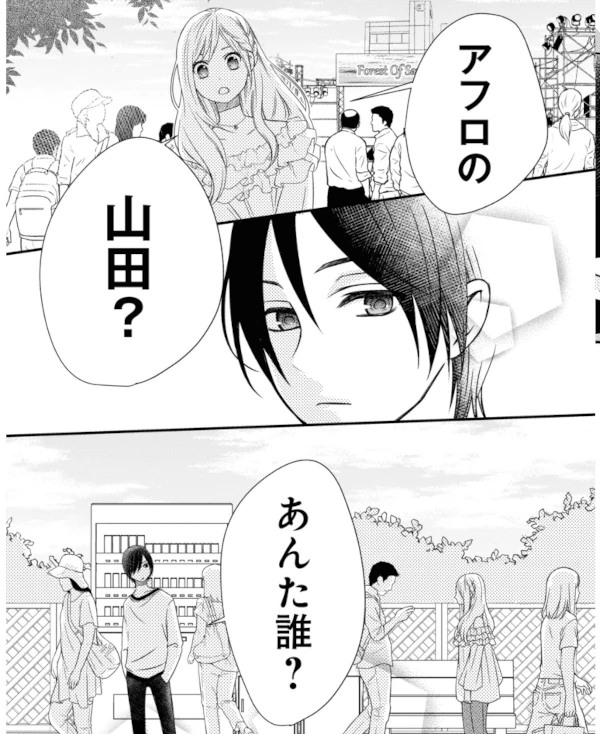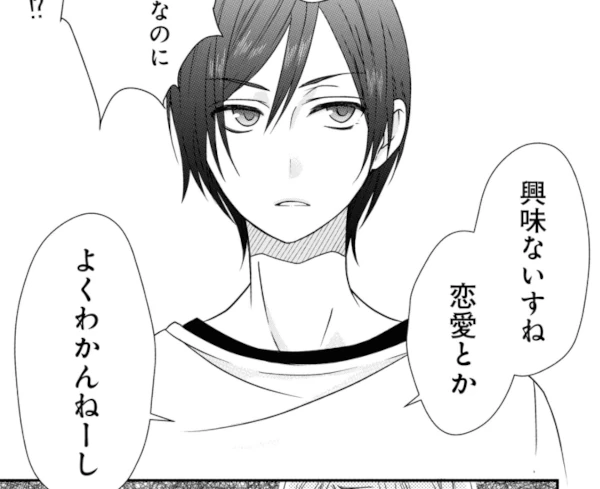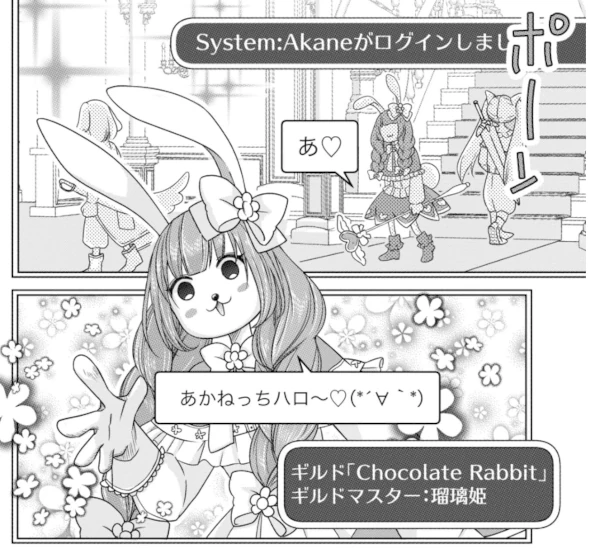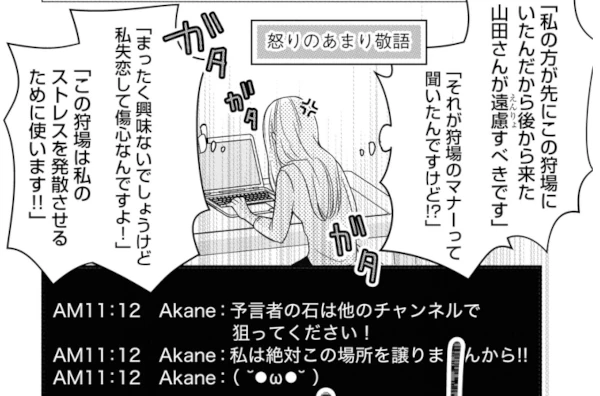This time, we’re introducing Yamada-kun to Lv999 no Koi wo Suru—a relatable love story perfect for learners who want to pick up laid-back honorific speech and modern Japanese rooted in online culture.
Work Information

Yamadakunto Lv999no koiwosuru(山田くんとLv999の恋をする)
Author: Mashiro
Publisher: KADOKAWA
Amount of text: moderate
Challenge level: ★★
Latest volume : Vol.10(Nov.2024 / Ongoing)
Story overview
My Love Ended in an Online Game… and Started There Again!?
Akane was dumped by her boyfriend—for another girl he met in an online game. While blowing off steam by hunting low-level monsters, she’s approached by a fellow guild member: a guy with a giant afro named Yamada. Out of guild camaraderie, she vents about her breakup, but Yamada simply replies with a blank expression, “Not interested.”
One day, Akane hears about a real-world event for the game. Hoping to run into her ex, she dresses up and heads to the venue—only to see him already there with his new girlfriend. Just then, as she’s jostled by the crowd and stumbles, a stunningly handsome guy with jet-black hair reaches out his hand to help her up…
The Appeal of This Manga
This story shines through its mix of virtual and real-world drama—where online games spark unexpected trouble, romance, and quirky interactions. The banter between a stoic, handsome male lead and the heartbroken heroine is especially entertaining, and the supporting cast adds plenty of charm. It also dives into the unique subculture of online gaming in Japan, giving readers a glimpse into its strange but fascinating dynamics.
The result is a light, modern romantic comedy that’s easy to read and highly relatable.

Why this manga is suitable for learning Japanese
This manga is not only entertaining but also highly recommended for Japanese learners for several reasons.
Rich Examples of Casual Polite Speech Among Young People
The male lead, Yamada, generally uses polite language with others, but his speech reflects a laid-back, youthful tone—like saying “Daijoubu su ka?”(〜すか?) or “Kyoumi wa nai su ne.”(〜すね) This kind of casual keigo (polite speech) isn’t ideal for formal situations, but for learners interested in how younger generations really talk, it offers a rare and valuable example of relaxed, real-world language use.

Natural Conversational Japanese from the Younger Generation
Since most characters are in their teens or twenties, the dialogue is packed with casual, natural Japanese that reflects how younger people actually speak. Unlike many fictional works, this manga uses relatively few exaggerated or stylized endings, making it a good model for learners aiming to sound more authentic.

Culture Spotlight
Inside Japan’s Online Gaming Culture: Language, Chat, and Community日本のオンラインゲームカルチャー
Ever seen a chat like this in a Japanese game?
「ラグひどすぎ!てか、このPT崩壊するわw」 “Ugh, so laggy! This party’s totally falling apart, lol.”
Japanese online games aren’t just about battles—they’re about building communities, fast reactions, and quick typing. In this world, language evolves fast, abbreviations rule, and teamwork depends on split-second communication. Let’s dive into how Japanese gamers talk—and what you can learn from them.

Beyond the Game: A Language and Culture All Its Own
Japan’s online gaming world isn’t just about defeating monsters or collecting rare gear—it’s a fully social experience where players interact constantly via chat windows, voice communication, and even fan communities.
This environment has led to a distinctive form of language use that blends slang, abbreviations, and even emoji-like text characters (known as 顔文字, kaomoji). Much of it is highly contextual and evolves quickly—like a dialect of its own.
For example:
・「おつー」 → Short for 「お疲れさま」 (“Good game” / “Nice job”)
・「主(ぬし)」 → The host or creator of a party/lobby
・「リセマラ中」 → Short for 「リセットマラソン」, the act of restarting a game repeatedly to get better initial rewards
・「ガチ勢」 vs 「エンジョイ勢」 → Hardcore gamers vs casual players
Understanding these terms helps you follow in-game conversations and even real-world gamer discourse.
Chat-Based Communication: Fast, Short, and Packed with Meaning
In multiplayer games—especially MMORPGs or team-based action titles—communication often happens in rapid-fire text bursts. Japanese players tend to be efficient and polite, even when things get intense.
Here’s a sample chat exchange during a boss fight:
A: よろしくですー!
B: よろー
C: MT任せた!
D: ヒール飛ばしますー
B: 範囲注意!
C: うわ、ワイプしたw
D: どんまい~ 次いける!
Translation:
・A: “Let’s do our best!”
・B: “Yep!”
・C: “Main Tank, it’s on you!”
・D: “I’ll keep healing!”
・B: “Watch for AoEs!”
・C: “Ugh, wiped lol.”
・D: “No worries! We got it next time!”
This style of language mixes formal expressions with shorthand, gaming-specific terms, and casual encouragement. It’s friendly, fast, and surprisingly rich in nuance.
Cultural Traits: Harmony, Politeness, and Team Play
Japanese online games often reflect broader social values, including:
・協調性 (kyōchōsei) – Team harmony
・遠慮 (enryo) – Polite restraint
・空気を読む (kūki o yomu) – Reading the mood
For example, even when someone underperforms, it’s rare to see direct criticism. Instead, players might say:
「惜しかったですね~」 (“That was close!”)
「もう少しでいけそう」 (“We almost had it.”)
This indirectness preserves group harmony, making the experience feel more inclusive but sometimes challenging for learners to interpret.
What It Means for Japanese Learners
Engaging with Japanese online games—and especially their chat systems—offers learners:
・Exposure to natural, real-time conversational Japanese
・A chance to learn abbreviations, slang, and online-specific expressions
・Insights into Japanese social behavior, like turn-taking and indirect communication
Plus, many games allow for asynchronous learning. You can pause and look up terms, compare expressions, or even mimic common phrases in your own practice.
Just be aware that:
・Casual or region-specific expressions may not appear in textbooks
・Slang evolves quickly; what’s popular now may fade in months
・You might see unusual kanji readings or typed shorthand, like using ログボ (log-in bonus) or 草 (lol, from 「w」 for warau)
Summary
Japan’s online game culture is more than just entertainment—it’s a vibrant, living world of language, etiquette, and emotion. Whether you’re playing for fun or studying the language, these digital spaces offer an authentic and exciting way to understand how Japanese people talk, connect, and play together.
So next time you enter a Japanese server and see a message like:
「初見さんいますか?ギミック説明します~」
(“Any first-timers? I’ll explain the mechanics!”)
—you’ll know exactly what’s happening, both in the game and in the culture behind it.
A Little Warning
Dense Text and Niche Phrases in Game Scenes
Some scenes—especially those set in online game chats—can be quite text-heavy, featuring long strings of dialogue and fast-paced exchanges. These segments may feel overwhelming for readers who aren’t yet comfortable with large amounts of Japanese text. In addition, the language used often includes slang, shorthand, and expressions unique to Japanese online gaming culture.
While this adds to the challenge, it also offers valuable exposure to how digital-native Japanese is used in real-world gaming contexts.

Work Information

Yamadakunto Lv999no koiwosuru(山田くんとLv999の恋をする)
Author: Mashiro
Publisher: KADOKAWA
Amount of text: moderate
Challenge level: ★★
Latest volume : Vol.10(Nov.2024 / Ongoing)
Here’s a safe and convenient way to purchase Japanese manga.
This Blog’s ConceptIn this blog, we are introducing manga that are not only highly captivating but also ideal for Japanese language learners. Studying Japanese through manga is both fun and effective. Manga allows you to understand the subtleties of keigo (honorifics), teineigo (polite speech), and casual conversation in Japanese. We hope you find works that match your interests and use them to enhance your Japanese learning journey.